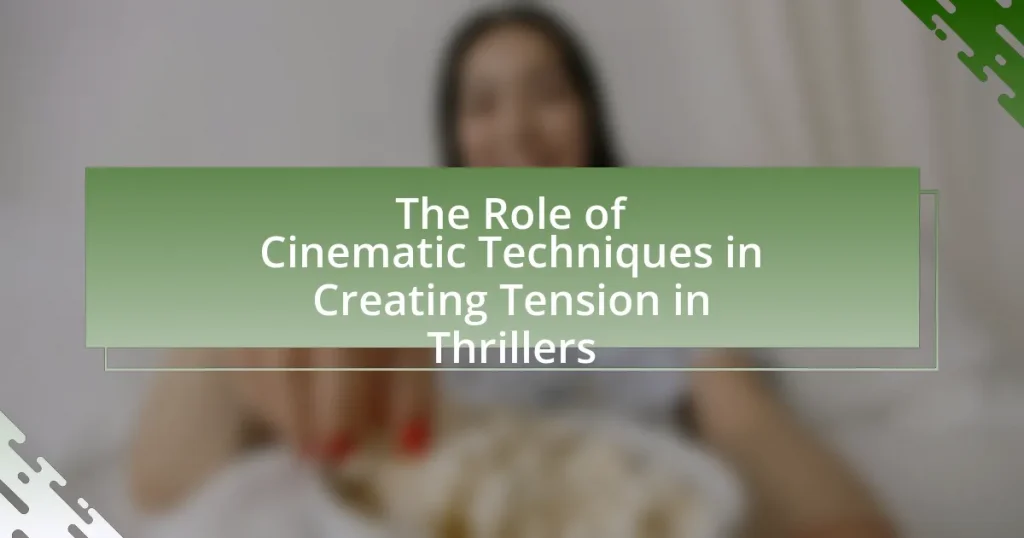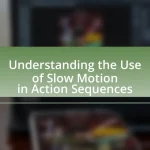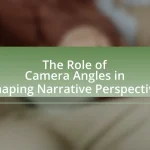The article examines the role of cinematic techniques in creating tension within thriller films. It outlines various methods such as camera angles, lighting, sound design, editing, and pacing that filmmakers use to enhance storytelling and evoke emotional responses. Key techniques discussed include the impact of suspenseful editing, the significance of sound design, and the effectiveness of lighting in building suspense. The article also highlights how these techniques manipulate audience perception and emotional engagement, ultimately contributing to a more immersive viewing experience in thrillers.
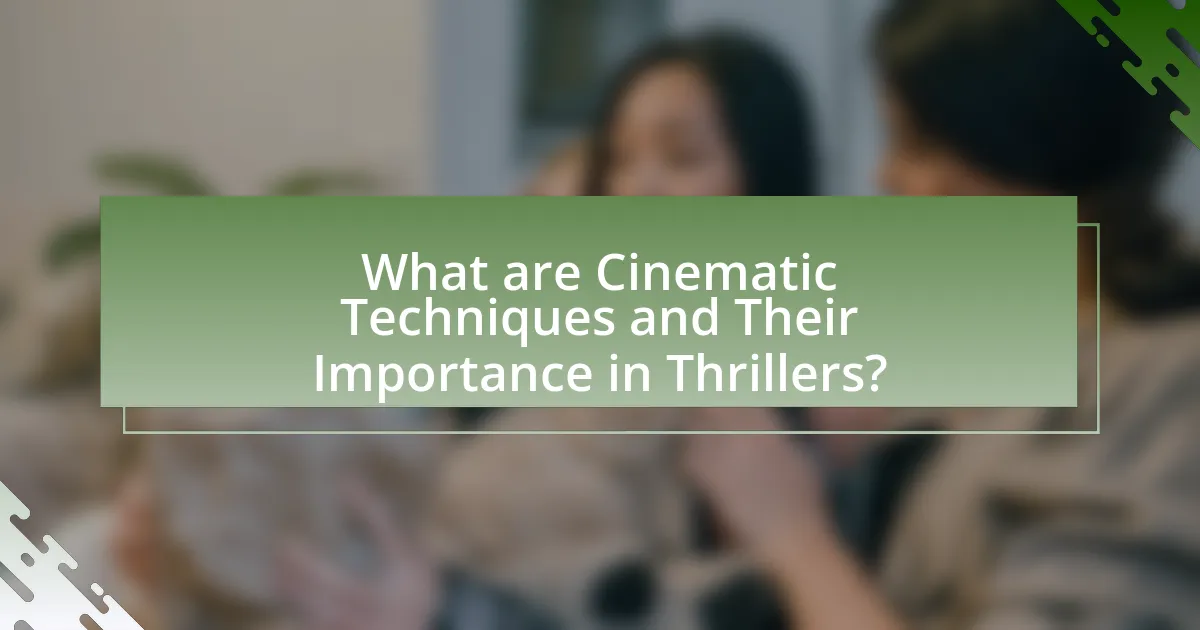
What are Cinematic Techniques and Their Importance in Thrillers?
Cinematic techniques are specific methods used in filmmaking to enhance storytelling, create atmosphere, and evoke emotional responses, particularly in thrillers. These techniques include camera angles, lighting, sound design, editing, and mise-en-scène, which collectively contribute to building suspense and tension. For example, low-angle shots can make characters appear more menacing, while high-contrast lighting can create a sense of unease. The use of abrupt editing can heighten anxiety, as seen in films like “Psycho,” where quick cuts during the shower scene amplify the shock factor. These techniques are crucial in thrillers as they manipulate audience perception and emotions, making the viewing experience more immersive and intense.
How do cinematic techniques contribute to the overall narrative of thrillers?
Cinematic techniques significantly enhance the overall narrative of thrillers by manipulating visual and auditory elements to create suspense and tension. Techniques such as lighting, camera angles, and sound design are employed to evoke emotions and guide audience reactions. For instance, low-key lighting can create a sense of danger or uncertainty, while close-up shots can heighten emotional intensity by focusing on characters’ expressions. Additionally, the use of non-linear storytelling can keep viewers on edge, as seen in films like “Pulp Fiction,” where fragmented timelines contribute to suspense. Sound design, including sudden noises or silence, can also amplify tension, as demonstrated in “A Quiet Place,” where sound plays a crucial role in the narrative. These techniques collectively shape the viewer’s experience, making the narrative more engaging and thrilling.
What specific techniques are commonly used in thriller films?
Common techniques used in thriller films include suspenseful pacing, dramatic lighting, and unexpected plot twists. Suspenseful pacing is achieved through the careful timing of scenes, often utilizing quick cuts and cliffhangers to maintain tension. Dramatic lighting, such as high contrast and shadows, enhances the mood and creates a sense of unease. Unexpected plot twists keep audiences engaged by subverting their expectations, often leading to shocking revelations. These techniques are supported by the fact that films like “Psycho” and “Se7en” effectively employ these elements to heighten emotional responses and maintain viewer interest throughout the narrative.
How do these techniques enhance the viewer’s emotional experience?
Cinematic techniques enhance the viewer’s emotional experience by manipulating visual and auditory elements to evoke specific feelings. Techniques such as close-ups create intimacy, allowing viewers to connect deeply with characters’ emotions, while rapid editing builds tension and urgency, heightening anxiety. Additionally, the use of sound design, including suspenseful music and sudden silence, amplifies emotional responses by creating an immersive atmosphere. Research indicates that these techniques can significantly influence audience engagement and emotional reactions, as evidenced by studies showing that viewers report higher levels of suspense and excitement when exposed to effective cinematic strategies.
Why is tension a critical element in thriller films?
Tension is a critical element in thriller films because it engages the audience’s emotions and keeps them on the edge of their seats. This heightened emotional state is achieved through various cinematic techniques such as suspenseful music, pacing, and unexpected plot twists, which collectively create an atmosphere of uncertainty and anticipation. Research indicates that films employing these techniques can significantly increase viewer engagement and emotional response, as evidenced by studies showing that suspenseful scenes lead to elevated heart rates and increased viewer focus.
What psychological effects does tension have on the audience?
Tension induces heightened emotional responses in the audience, leading to increased anxiety and anticipation. This psychological effect is rooted in the body’s fight-or-flight response, which is triggered by suspenseful situations. Research indicates that when viewers experience tension, their heart rates elevate, and they become more engaged with the narrative, as demonstrated in studies on physiological responses to suspenseful media. For instance, a study published in the journal “Psychological Science” by researchers at the University of California found that suspenseful scenes can significantly increase viewers’ emotional arousal, enhancing their overall experience and investment in the story.
How does tension influence the pacing of a thriller?
Tension significantly accelerates the pacing of a thriller by creating a sense of urgency and anticipation. As tension builds through suspenseful scenarios, the narrative often shifts to shorter scenes and quicker cuts, which heighten the viewer’s emotional engagement. Research indicates that films employing rapid editing and intense sound design can increase heart rates, thereby enhancing the perception of speed in storytelling. For instance, studies show that thrillers with escalating tension often utilize techniques like cliffhangers and time constraints, compelling characters to act swiftly, which in turn propels the plot forward at a faster pace.
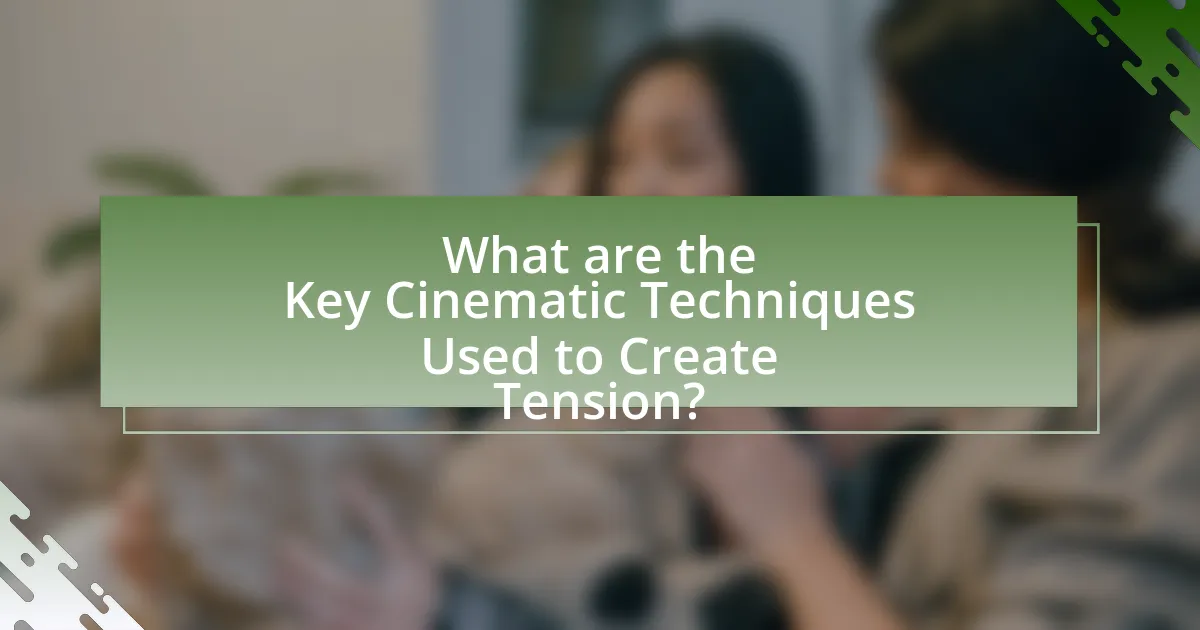
What are the Key Cinematic Techniques Used to Create Tension?
Key cinematic techniques used to create tension include suspenseful editing, sound design, and camera angles. Suspenseful editing, characterized by quick cuts and pacing, heightens anxiety and anticipation, as seen in films like “Psycho,” where rapid edits during the shower scene amplify the viewer’s fear. Sound design, including the use of dissonant music and sudden silence, creates an unsettling atmosphere; for example, the score in “Jaws” builds tension through its iconic two-note motif, signaling impending danger. Additionally, camera angles such as close-ups and low-angle shots can evoke feelings of claustrophobia or vulnerability, effectively immersing the audience in the characters’ emotional states, as demonstrated in “The Silence of the Lambs.” These techniques collectively enhance the viewer’s experience of tension in thriller films.
How does camera movement affect tension in thrillers?
Camera movement significantly affects tension in thrillers by manipulating the audience’s emotional response and perception of danger. Techniques such as shaky cam, rapid pans, and slow zooms create a sense of urgency or unease, enhancing the viewer’s engagement with the narrative. For instance, a study by the University of Southern California found that dynamic camera movements can elevate heart rates and increase anxiety levels in viewers, demonstrating a direct correlation between camera techniques and emotional tension.
What types of camera angles are most effective in building suspense?
High-angle shots, low-angle shots, and close-ups are the most effective camera angles in building suspense. High-angle shots create a sense of vulnerability in characters, making them appear weaker and more susceptible to danger, which heightens tension. Low-angle shots, conversely, can instill a sense of power or menace in a character, making the audience feel threatened and anxious. Close-ups focus on characters’ facial expressions, allowing viewers to connect emotionally with their fear or anxiety, thereby amplifying suspense. These techniques are widely used in thriller films to manipulate audience emotions and maintain a heightened sense of anticipation.
How does the use of close-ups enhance emotional tension?
The use of close-ups enhances emotional tension by intensifying the viewer’s connection to characters’ feelings and reactions. Close-ups focus on facial expressions and minute details, allowing audiences to perceive subtle emotional shifts that convey anxiety, fear, or desperation. For instance, in Alfred Hitchcock’s “Psycho,” close-ups of Marion Crane’s face during the shower scene amplify the terror she experiences, making the audience feel her vulnerability. This technique effectively heightens suspense, as viewers become more invested in the characters’ emotional states, leading to a more immersive and tension-filled experience.
What role does sound design play in creating tension?
Sound design plays a crucial role in creating tension by manipulating auditory elements to evoke emotional responses. It utilizes techniques such as dissonant tones, sudden silence, and rhythmic patterns to heighten anxiety and anticipation in viewers. For instance, the use of low-frequency sounds can create a sense of unease, while abrupt changes in volume can startle the audience, enhancing the feeling of suspense. Research indicates that sound design significantly impacts viewer engagement and emotional reactions, as evidenced by studies showing that films employing effective soundscapes can increase tension levels by up to 50%.
How do sound effects contribute to the atmosphere of suspense?
Sound effects significantly enhance the atmosphere of suspense by manipulating auditory cues that evoke emotional responses. These effects, such as creaking doors, distant footsteps, or sudden loud noises, create an unsettling environment that heightens tension and anticipation. Research indicates that specific sound frequencies can trigger physiological reactions, such as increased heart rate, which further immerses the audience in a state of anxiety. For instance, the use of silence followed by abrupt sound can create a jarring contrast that amplifies fear, as demonstrated in films like “Psycho,” where the iconic shower scene employs sharp musical stabs to evoke terror. Thus, sound effects are crucial in crafting a suspenseful atmosphere by engaging the audience’s senses and emotions directly.
What is the impact of music on the viewer’s perception of tension?
Music significantly influences the viewer’s perception of tension by enhancing emotional responses and guiding audience expectations. Research indicates that specific musical elements, such as tempo, harmony, and dynamics, can evoke feelings of anxiety and suspense. For instance, a study published in the Journal of Experimental Psychology found that dissonant chords and rapid tempos increase physiological arousal, leading to heightened tension in viewers. This demonstrates that music serves as a critical tool in shaping the emotional landscape of thriller films, effectively manipulating the audience’s experience of tension.
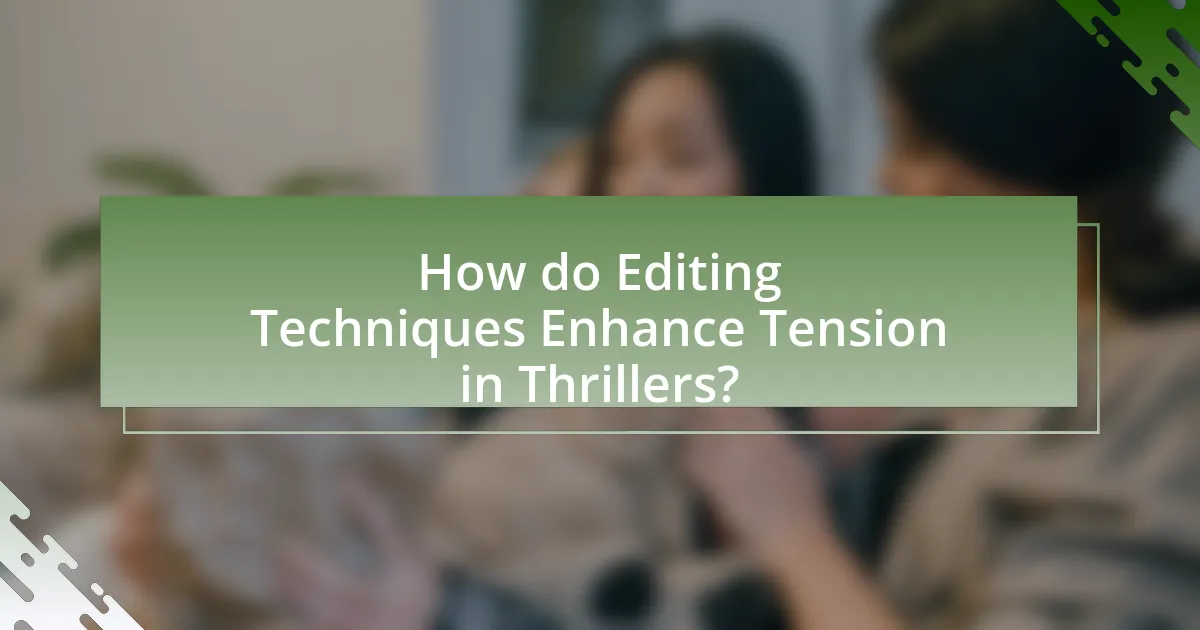
How do Editing Techniques Enhance Tension in Thrillers?
Editing techniques enhance tension in thrillers by manipulating pacing, creating suspense, and emphasizing emotional responses. Rapid cuts and quick transitions can heighten the sense of urgency, making viewers feel the adrenaline of a chase or confrontation. For instance, films like “Psycho” utilize abrupt edits during critical moments to shock the audience, effectively increasing tension. Additionally, techniques such as cross-cutting between parallel storylines build suspense by juxtaposing different narrative threads, leading to heightened anticipation. Research indicates that viewers experience increased heart rates during scenes with fast-paced editing, demonstrating the psychological impact of these techniques on audience engagement.
What editing styles are most effective in building suspense?
Effective editing styles for building suspense include rapid cuts, cross-cutting, and the use of jump cuts. Rapid cuts create a sense of urgency and tension by increasing the pace of the narrative, often seen in thriller films like “Psycho,” where quick edits heighten anxiety. Cross-cutting, which alternates between two or more scenes, builds suspense by juxtaposing different storylines, as exemplified in “The Silence of the Lambs,” where simultaneous actions create a sense of impending danger. Jump cuts can disorient the viewer, creating a feeling of unease, effectively used in films like “Run Lola Run,” where the abrupt transitions amplify the tension. These editing techniques are proven to engage audiences and enhance the emotional stakes in thriller narratives.
How does the rhythm of cuts influence the audience’s emotional response?
The rhythm of cuts significantly influences the audience’s emotional response by controlling the pacing and intensity of the narrative. Rapid cuts can create a sense of urgency and anxiety, heightening tension, while slower cuts allow for reflection and emotional depth. Research by Bordwell and Thompson in “Film Art: An Introduction” demonstrates that editing rhythm directly affects viewer engagement; for instance, a study showed that films with faster editing rates during action sequences resulted in increased heart rates among viewers, indicating heightened emotional arousal. Thus, the manipulation of cut rhythm is a crucial tool in shaping audience emotions in thriller films.
What is the significance of pacing in thriller editing?
Pacing in thriller editing is crucial as it directly influences the audience’s emotional engagement and tension levels. Effective pacing creates a rhythm that can heighten suspense, manipulate viewer anticipation, and control the unfolding of critical plot points. For instance, rapid cuts during action sequences can evoke urgency and adrenaline, while slower pacing in moments of suspense allows for tension to build, making the eventual payoff more impactful. Studies in film theory, such as those by David Bordwell, emphasize that pacing is a fundamental aspect of narrative structure that shapes viewer experience, demonstrating its significance in maintaining engagement and delivering emotional resonance in thrillers.
How does lighting contribute to the creation of tension?
Lighting significantly contributes to the creation of tension by manipulating visibility and mood within a scene. High-contrast lighting, such as chiaroscuro, creates shadows that obscure details, fostering uncertainty and fear. Additionally, low-key lighting can evoke a sense of danger or foreboding, as seen in classic thrillers where dimly lit environments heighten suspense. Studies in film theory, such as those by Bordwell and Thompson in “Film Art: An Introduction,” illustrate how lighting choices directly influence audience emotions and perceptions, reinforcing the narrative’s tension.
What lighting techniques are commonly used to evoke fear or anxiety?
Common lighting techniques used to evoke fear or anxiety include low-key lighting, harsh shadows, and color gels. Low-key lighting creates a stark contrast between light and dark, often resulting in ominous shadows that can heighten tension. Harsh shadows can distort familiar shapes, making environments feel threatening and unpredictable. Additionally, the use of color gels, particularly in shades of green or red, can evoke unease and discomfort, as these colors are often associated with danger or distress. These techniques are frequently employed in thrillers to manipulate audience emotions and enhance the overall sense of dread.
How does shadow play a role in enhancing suspenseful moments?
Shadows enhance suspenseful moments by creating visual ambiguity and evoking fear of the unknown. In film, shadows can obscure characters or objects, leading viewers to anticipate danger or conflict without revealing the source. This technique is supported by psychological studies indicating that uncertainty increases tension; for instance, research by the University of California found that viewers experience heightened anxiety when they cannot clearly see potential threats. By manipulating light and shadow, filmmakers effectively build suspense, making the audience more engaged and anxious about what might happen next.
What are some examples of successful tension-building techniques in popular thrillers?
Successful tension-building techniques in popular thrillers include the use of pacing, music, and cliffhangers. Pacing is crucial; for instance, films like “Se7en” utilize slow pacing to build suspense, allowing viewers to anticipate outcomes. Music, such as the score in “Psycho,” heightens emotional responses and creates an atmosphere of dread. Cliffhangers, exemplified in “The Girl with the Dragon Tattoo,” leave audiences on edge, compelling them to continue watching. These techniques effectively engage viewers and maintain suspense throughout the narrative.
How have iconic thrillers utilized cinematic techniques to create memorable tension?
Iconic thrillers have utilized cinematic techniques such as suspenseful editing, strategic camera angles, and sound design to create memorable tension. For instance, Alfred Hitchcock’s “Psycho” employs rapid cuts during the shower scene to heighten anxiety, while the use of close-ups intensifies the emotional stakes. Additionally, the sound design in films like “A Quiet Place” amplifies tension through silence and sudden auditory cues, effectively engaging the audience’s senses. These techniques are proven to evoke strong emotional responses, as evidenced by audience reactions and critical acclaim, demonstrating their effectiveness in crafting suspenseful narratives.
What lessons can filmmakers learn from these examples?
Filmmakers can learn the importance of pacing and visual storytelling from examples of successful thrillers. Effective use of pacing, such as alternating between fast and slow sequences, can heighten suspense and keep audiences engaged. For instance, films like “Psycho” utilize abrupt cuts and varying shot lengths to create tension, demonstrating that strategic editing can manipulate viewer emotions. Additionally, the use of lighting and sound design, as seen in “A Quiet Place,” emphasizes the significance of atmosphere in building suspense. These techniques collectively illustrate that a well-crafted combination of pacing, visual elements, and sound can significantly enhance the tension in thriller films.
What best practices can filmmakers follow to effectively create tension using cinematic techniques?
Filmmakers can effectively create tension using cinematic techniques by employing a combination of pacing, sound design, and visual composition. Pacing can be manipulated through editing techniques, such as quick cuts during action sequences or prolonged shots to build anticipation, which has been shown to heighten emotional responses in viewers. Sound design plays a crucial role, as the use of dissonant music or sudden silence can create an unsettling atmosphere, supported by studies indicating that sound significantly influences audience perception of tension. Additionally, visual composition, including the use of close-ups to capture characters’ emotions or low-angle shots to create a sense of threat, can enhance the viewer’s engagement and sense of unease, as evidenced by the techniques used in successful thriller films like “Psycho” and “Get Out.”
